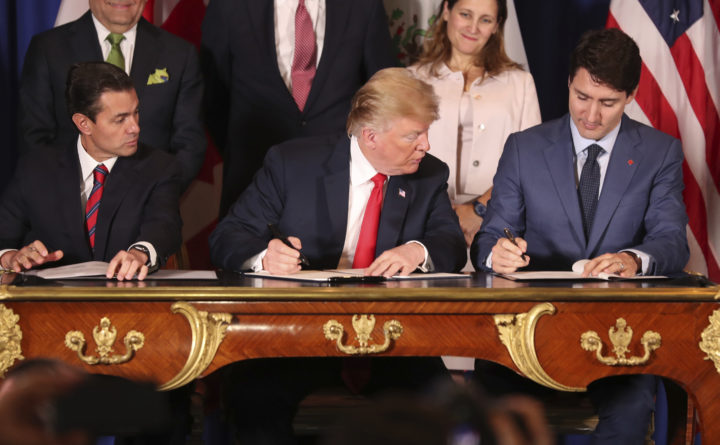
The U.S., Canada and Mexico signed a new trade deal championed by President Donald Trump to replace the quarter-century-old NAFTA pact, capping a year of intense negotiations and offering a glimmer of certainty amid rising global tensions over trade.
Trump, Canadian Prime Minister Justin Trudeau and outgoing Mexican President Enrique Pena Nieto signed an authorization for the deal on Friday morning in Buenos Aires on the sidelines of the Group of 20 summit, with their ministers signing it shortly after. The vast majority of the pact still needs to be ratified by lawmakers in the three countries but the signing enacts a handful of immediate protections, such as from auto tariffs.
The deal now heads to ratification, almost certainly by the next U.S. Congress, where some Democrats who will have a majority in the House starting in January are warning they may not be satisfied by the terms. Uncertainties remain, as the original 1994 pact stay in effect, and tariffs on steel and aluminum continue to be a major irritant. Nonetheless, the signing concluded an arduous process that was marked by repeated threats from Trump to exit the continent’s free-trade zone.
“This has been a battle,” Trump said in remarks right before the leaders put pen to paper. “This is a model agreement that changes the trade landscape forever.”
The new deal is known as the U.S.-Mexico-Canada Agreement, though the Canadians have avoided calling it that. The U.S. and Mexico struck a deal in August, followed by Canada on Sept. 30. Its key provisions include:
— Raising the North American content requirement in autos traded tariff-free under the deal to 75 percent, from 62.5 percent, and requiring that 40 percent of a vehicle be made at high wages;
— Adding a clause for regular review of the deal, with the first coming after six years;
— Overhauling dispute panels, largely killing investor-state panels but preserving dispute settlement panels; and
— Expanding U.S. dairy farmers’ access to Canada’s protected market.
The three countries sealed the new trade accord a day before Trump is set to meet with Chinese President Xi Jinping to discuss a possible truce in their tit-for-tat trade war. The U.S. leader has touched off a global showdown over trade by threatening a broad range of tariffs to force changes in trade practices that he considers unfair to American industry. No one has been spared in that trade fight — not even Canada and Mexico, the top buyers of U.S. goods.
Steel and aluminum tariffs, once seen as a pressure tactic in trade talks, remain in place. The U.S. continues to push for a quota in exchange for lifting the tariffs on Canada and Mexico, which have applied their own retaliatory levies. Canada has said it will lift its tariffs once the U.S. removes its own. The unresolved dispute will sap private sector support for the USMCA deal, said Rufus Yerxa, president of the National Foreign Trade Council in the U.S.
Trudeau pressed on Friday for a resolution. “Donald, it’s all the more reason why we need to keep working to remove the tariffs on steel and aluminum between our countries,” he said at the ceremony.
U.S. Trade Representative Robert Lighthizer said talks on steel and aluminum will continue next week, and indicated they’d be handled separately with Canada and Mexico. He declined to say whether quotas would be required to lift the tariffs.
“So what the president has asked me to do is to find a way forward that is satisfactory to the Mexicans and to the Canadians in separate agreements,” he said. “It was something that was not going to happen while we were doing this very complicated agreement.”
The signing was done on Pena Nieto’s last day in office, a target the countries had pushed for in a bid to have it sealed before his successor, Andres Manuel Lopez Obrador, takes power Saturday.
Trump acknowledged the often difficult path during negotiations and praised the outcome. “We’ve taken a lot of barbs, and a little abuse, and we got there and it’s great for all of our countries,” he said.
U.S. lawmakers, both Democrats and Republicans, have recently said the deal needs changes in order to gain their support. Lopez Obrador’s Morena party, which holds a majority in Mexico’s Senate, may also seek revisions. Trudeau has a majority in Canada’s House of Commons but faces an election in October.
Trump expressed optimism about getting the deal blessed by U.S. lawmakers. “I look forward to working with members of Congress,” he said. “It’s been so well reviewed I don’t expect to have much of a problem.”
Democratic Sen. Chuck Schumer said the deal needs stronger environmental and labor protections. “The Congress has a role in crafting ‘implementing legislation’ to make sure the deal benefits and protects middle-class families and working people, and isn’t simply a rebranding of the same old policies that hurt our economy and workers for years,” he said in a statement. Lighthizer said it was possible to address some concerns in implementing legislation, but said the deal isn’t being reopened.
The parts of the deal that kick in immediately upon signing are 13 provisions known as “side letters.” The foremost allow exclusions from any U.S. auto tariffs up to a certain quota that’s set well above current Canadian and Mexican auto production. The side letters also include deals between the U.S. and Mexico on biologic drugs, cheese names and auto safety standards; and deals between the U.S. and Canada on wine, water and energy.
Bloomberg writer Eric Martin contributed to this report.
This article originally appeared on www.bangordailynews.com.







